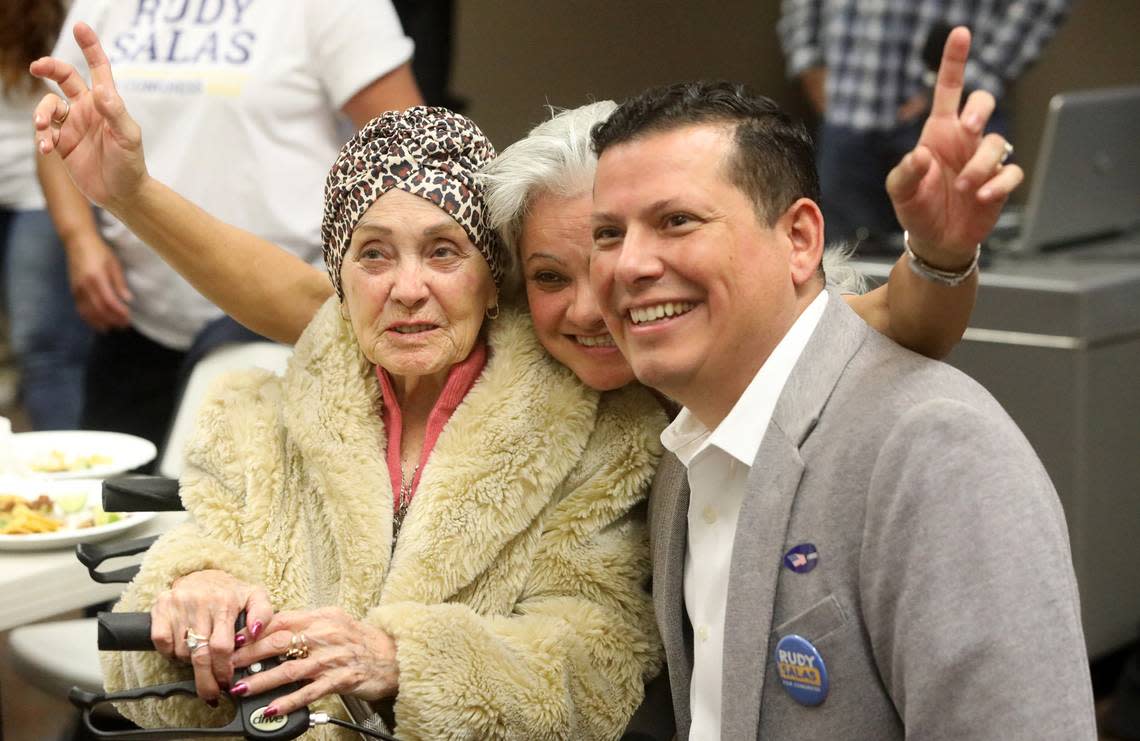Fundraising will be key to tossup Central Valley congressional races. Who has the edge so far?

Democratic challengers far out-raised vulnerable Republican congressmen in two Central Valley tossup races to start 2024, federal election reports filed this week show.
The Democrats need to build on that momentum to approach the Republican incumbents’ massive cash reserves.
In repeat November match-ups for two of the nation’s closest U.S. House races, Democrats Adam Gray and Rudy Salas each raked over $1 million in the first quarter of the year, which overlapped with California’s March 5 primary election.
Gray is challenging freshman Rep. John Duarte in California’s 13th Congressional District. Salas is contesting Rep. David Valadao in California’s 22nd.
It was the two Democrats’ most lucrative quarter during the 2022 and 2024 election cycles.
Salas, a former Assemblyman from Bakersfield, pulled in almost $1.33 million between the start of 2024 and the end of March, Federal Election Commission filings show. Valadao, R-Hanford, collected a little over $672,000.
But Valadao ended March with more than $1.64 million in the campaign bank. Salas had over $754,000.
“I’m truly thankful to have so many people believe in and donate to our campaign,” Salas said in a statement.
Valadao’s campaign declined to comment for this story.
Gray, a former Assemblyman from Merced, was closer to Duarte, R-Modesto. Gray raised more than $1.03 million. Duarte, a little more than $580,000.
Still, Duarte ended March with over $1.81 million on hand. Gray had just more than $1.15 million.
“This is one of the most important races in America. If we’re going to get rid of this do-nothing Congress, it starts here in our Valley,” Gray said in a statement sent to The Bee. “That’s why people have been generous.”
“I want to thank all of the hardworking families who are supporting our campaign to bring down the cost of groceries, gas, and housing,” Duarte said in a statement sent to The Bee.
How competitive are these Central Valley congressional races?
This rural stretch of San Joaquin Valley, where a little bit of money can go a longer way than in other parts of California, will gather lots of national attention because of its competitive the House races. The elections here could help determine whether Democrats or Republicans control the House of Representatives in 2025. Republicans currently have a slim majority.
Races in California’s 13th and 22nd — areas represented by Republicans that President Joe Biden would have won in 2020 had the current district maps been in place — are toss-ups, election analysts say.
Both the 13th and 22nd have more Democrats than Republicans (42% in each are registered Democrats, 29% are Republicans in the 13th and 27% in the 22nd, and 21-22% in each are no-party-preference). They are both Latino-majority voting districts.
The 13th district, which holds all of Merced County and chunks of Madera, Stanislaus, Fresno and San Joaquin counties, would have elected Biden in 2020 by 11 percentage points. The 22nd, which includes most of Kings County and parts of Tulare and Kern counties, would have picked Biden by 13 percentage points.
These areas generally have low turnout compared to the rest of the state, leading to older, conservative, white voters having a larger say.
Turnout statewide tends to be at its highest during the November elections of presidential years, noted Paul Mitchell, founder and vice president of election-data tracker Political Data, Inc., but history indicates turnout here will still be lower than in other California districts.
Campaign finances are far from the only factor in determining how an election will play out. However, cash on hand lets candidates spend more on advertisements, events and other supplies necessary to a campaign. It’s also good to reserve money in case of unexpected issues down the line.
Campaign funds come from a wide range of sources not specified in the candidate’s official report, from individual donors, political action committees, other lawmakers and joint-fundraising groups.
What happened in California’s primary election?
Salas, 47, already had to spend about double what Valadao, 47, did in the first three months of 2024 because of the highly anticipated primary where two Democrats and two Republicans were on the ballot.
National Democrats, concerned that low turnout and divided left-leaning voters would lock Salas out of this competitive November race, threw their weight and fundraising behind him to overcome in-party challenger State Sen. Melissa Hurtado, D-Bakersfield.
Valadao too faced an in-party challenge from Chris Mathys, an ardent Trump supporter, in the 22nd. But that challenge was expected to be less competitive, experts said before the primary.
Salas spent nearly $866,000 while Valadao used almost $474,000 in the first three months of the year.
Duarte, 57, and Gray, 46, were the only two candidates in the March primary for California’s 13th. Gray spent a little more than $246,000; Duarte, almost $184,000.
The races in these districts where highly competitive in 2022 too.
Salas came within 3 percentage points of Valadao in 2022. At around this time that year, he had about half of the cash on hand that he has now.
Duarte, a farmer and businessman, beat Gray by fewer than 600 votes in November 2022 — the second-closest House race in the nation that year.
Gray served the area around his hometown in the Assembly for a decade.
Salas too was in the Assembly for his hometown area for a decade. Valadao, minus one term where he lost his seat to a Democratic opponent, has represented the area around his hometown in Congress since 2013.






